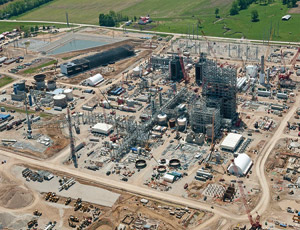The market for developing power- generation facilities in the United States remains weak in mid-2010 as utilities, faced with lagging demand for electricity, continue to put off plans for new plants.

Not all the news is bad, though. Engineering and construction executives say the need for new generating capacity will grow as the economy rebounds and as tightening environmental regulations force the retirement of older coal plants, which will be replaced with new facilities powered by natural-gas or renewable energy sources.
They also say the U.S. is poised for a boom in transmission-line development and that construction starts on the nation’s first new nuclear plants in a generation are on the horizon.
Still, the power-generation development market “is pretty dormant right now,” says Alan Champagne, vice president of business development at Englewood, Colo.-based CH2M Hill. The economic downturn and milder-than-normal weather in much of the country over the past year or so, he says, “has given some utilities the view—and maybe an incorrect view—that demand for electricity will be down” and that they can slow the pace of adding new capacity.
Dean Oskvig, president and CEO of B&V Energy, the global energy business of Black & Veatch, Overland Park, Kan., adds that utilities also are in “a waiting mode to get clarity regarding the future cost of carbon, emission rules and other things like that—all against the backdrop of a falloff in demand” for power during the recession.
Gas Plants and Renewables Dominate
With the shift toward cleaner and greener energy sources a certainty, says Tim Gelbar, president of AMEC’s Power and Process Americas subsidiary, “the market in the short term will be focused on wind, solar, biomass and other renewables ... and gas-fired generation.” AMEC’s U.S. headquarters is in Atlanta.
Says Gelbar, development of renewables is being driven primarily by state renewable portfolio standards that require utilities to secure increasing portions of their electricity from green sources as well as by the likelihood that a federal RPS will be implemented soon.
Babcock & Wilcox, a subsidiary of Houston-based McDermott International, has been doing a lot more work on biomass-fired projects, including the conversion of older, “unscrubbed” coal plants into facilities powered by wood waste, says Mark Low, vice president of service projects at B&W’s power-generation group. “We are doing a lot of studies for a lot of utilities, mostly in anticipation of a federal renewables mandate,” Low says.
For all the talk of renewables, however, the development of wind and solar projects continues to lag, mostly due to utilities’ reluctance to enter into long-term power-purchase agreements as well as to related financing problems. According to the American Wind Energy Association, only 539 MW of wind capacity was installed in the first three months of 2010—the lowest first-quarter result since 2007.
Two mainstays of the U.S. power industry—coal and nuclear—face different futures. While several major coal projects are under construction, including Duke Energy Indiana’s $2.9-billion integrated gasification/combined-cycle plant in Edwardsport, Ind., with San Francisco-based Bechtel serving as the 630-MW plant’s engineering-procurement-construction management contractor, the number of coal plants being planned continues to fall. Firms say they expect fewer coal plants to be built over the next few years due to stricter emissions rules.
On the other hand, prospects for nuclear projects—particularly plant “uprate” work—are good, says Jeff Merrifield, senior vice president of the power group at The Shaw Group, Baton Rouge, La. Merrifield also is upbeat about “new build” nuclear. Shaw is the EPC contractor for several planned Westinghouse AP1000 projects, including the two-unit, 2,234-MW expansions planned at the Vogtle plant near Waynesboro, Ga., the first to receive a federal loan guarantee.
| Rank* | Firm | $ Mil. |
|---|---|---|
| 1 | The Shaw Group Inc. | 681.0 |
| 2 | Bechtel | 566.0 |
| 3 | Black & Veatch | 565.1 |
| 4 | URS Corp. | 523.0 |
| 5 | Sargent & Lundy LLC | 522.6 |
| 6 | AECOM Technology Corp. | 410.8 |
| 7 | CH2M HILL | 325.0 |
| 8 | Burns & McDonnell | 313.7 |
| 9 | Fluor Corp. | 292.1 |
| 10 | Tetra Tech Inc. | 274.0 |
| 11 | Zachry Holdings | 256.4 |
| 12 | AMEC | 252.4 |
| 13 | Parsons Brinckerhoff Inc. | 228.0 |
| 14 | McDermott International Inc. | 209.3 |
| 15 | WorleyParsons Group Inc. | 193.7 |
| 16 | POWER Engineers Inc. | 170.4 |
| 17 | Kiewit Corp. | 161.5 |
| 18 | HDR | 145.2 |
| 19 | Enercon Services Inc. | 135.1 |
| 20 | Burns and Roe Group Inc. | 133.3 |
| 21 | TRC Cos. Inc. | 109.3 |
| 22 | Stanley Consultants Inc. | 91.3 |
| 23 | MWH Global | 85.6 |
| 24 | Science Applications International Corp. (SAIC) | 82.6 |
| 25 | MACTEC Inc. | 73.0 |
| *Based on 2009 contracting revenue from power as reported in enr’s survey of leading contractors and design firms. | ||


Post a comment to this article
Report Abusive Comment